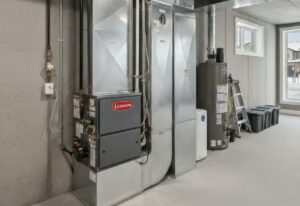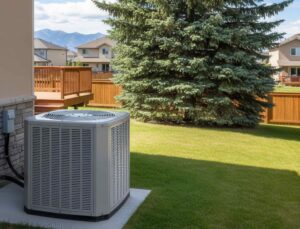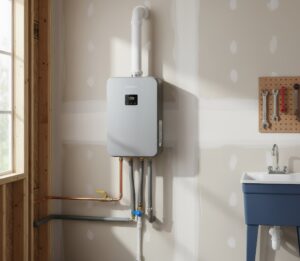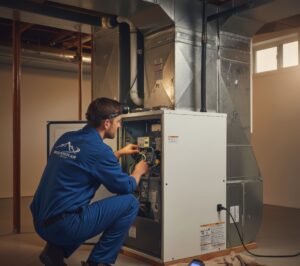The indoor air quality as well as the heating and cooling performance of your HVAC system relies partly on your air conditioning and furnace filters.
These simple but essential components filter out unwanted airborne particles that could otherwise start causing problems with the normal function of your system.
But how often should you change the furnace filters? Does the same apply to all heating systems in all Alberta households? And how do you change the filter when it’s time?
Let’s take a closer look….
How often to change furnace filters?
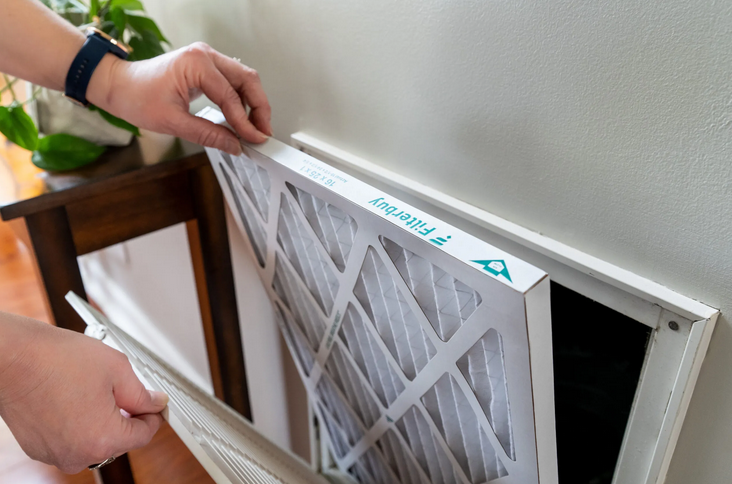
Cleaning or changing your furnace filters is an essential part of regular furnace maintenance. Most homes in Alberta should check their furnace filters every month and replace them at least every three months.
However, it’s best to check the manufacturer’s recommendations on how often to change your furnace filter. Some filters may need replacing every month during the coldest parts of the year while others last a little longer and can get by for six or even nine months at a time.
Some filters are disposable; others are reusable and must be cleaned but there are no hard and fast rules to this. Check with the manufacturer how to maintain your furnace’s filter system—by replacing or cleaning.
Why change furnace filters so often?
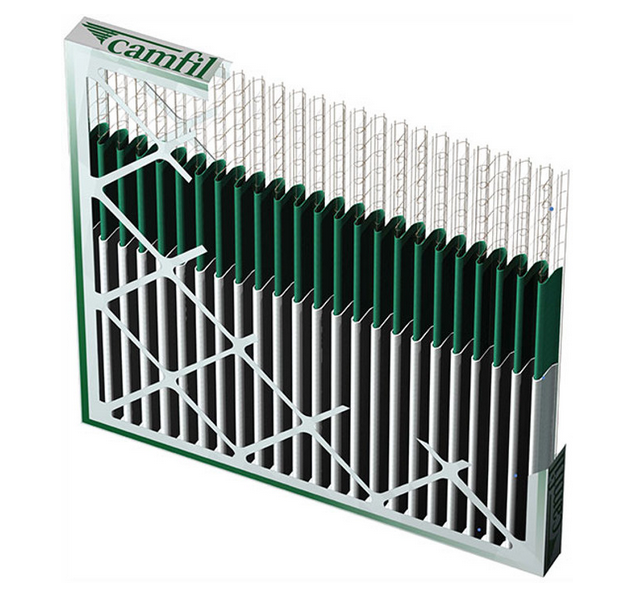
The general rule is to “go with the flow”, which is a handy way to remember. The air in your home will then be properly filtered and maintain a healthy quality and flow through your furnace unit and your home.
You could even draw the airflow direction arrow with a permanent marker on the furnace or ductwork so that you have a visual reminder of the direction in which to install furnace filters.
Why should you change your furnace filters every 90 days?
Alberta homeowners don’t need reminding how important their furnace is for heating cold air and delivering clean, heated air to a home—but it does often sit quietly doing its job in a basement, attic or closet.
Out of sight should not be out of mind. A furnace is a major cost for most Alberta homes and homeowners should protect their investment. The unit needs regular cleaning and maintenance to keep it performing at peak and to avoid issues cropping up.
To do its job properly, air must circulate freely through the system so that all components perform efficiently. If your home is not being heated effectively (or the air quality is poor), the problem could stem from a clogged or dirty air filter.
In fact, dirty furnace air filters are responsible for many common furnace problems and are one of the most frequent culprits for poor heating performance.
Filters gather dust, dirt, and other airborne contaminants from the air just before it is pulled into the furnace system. When the grime starts to clog the filters, it impedes airflow and can even shut down the entire heating system, requiring emergency furnace repairs in the most extreme cases
Clogged furnace filters can also be a particular problem for allergy sufferers if the indoor air quality is compromised.
Thankfully, the fix is usually straightforward and affordable to fix. Simply changing the air filter every few months can make a huge difference to the indoor air quality, the efficiency of the home’s heating system, and your family’s comfort and wellbeing:

That’s why it’s so important!
Common problems with dirty furnace filters
Dirty furnace filters can quickly start to cause problems for your HVAC system. Issues often crop up precisely during the time of year when you rely on your furnace the most and need it to work its hardest.
Components in the furnace system can be negatively impacted by contaminated air, which has knock-on effects on your home in the longer term:
- Cold home from poor heating performance
- Damage to the heat exchanger or other components
- Higher energy costs from an overworked system
- Poor indoor air quality
- High furnace repair bills
- Furnace failure
- Shortened furnace lifespan

What factors impact how often you should change your furnace filters?
In warm climates, some HVAC systems have no heating element but even single air filtration HVAC systems require air filters.
Virtually all HVAC systems in Alberta have furnace filter systems. Our climate is tough on furnaces and we ask them to keep us cozy and warm month after month. The fact that the furnace is in use and working hard for most of the year necessitates frequent changing of the air filters.
High-efficiency disposable filters are more common in Calgary, though they are the less eco-friendly and budget-friendly option. Some HVAC companies consider them more effective than washable electrostatic filters, especially at removing larger particles like pet dander. You can buy filters online or in hardware stress in packs of multiple units
Most high-efficiency disposable filters are highly effective, capturing up to 95 percent of larger airborne particles in the home. Their effectiveness is measured by the Minimum Efficiency Reporting Value (MERV rating) and the best filters are rated 9 to 12 MERV. Most reusable filters have a lower MERV rating than this.

Some homes in Alberta need to change their furnace filters more or less frequently than others. This largely depends on the type of filter used in your HVAC system and the conditions inside your home…
Conditions in your home
Some contaminants clog up filters quicker than others. If you have a dog or cat in your home, for instance, pet dander is likely to make its way into the heating system at some point. This should be filtered out if your system does its job properly, potentially clogging your furnace filter.
Also, the number of occupants in the home may affect the general indoor environment. Larger households generally create more airborne dust, particles, and other contaminants to be filtered out. If any household members suffer from allergies, changing air filters a little more regularly is good practice.
During the winter months in Calgary, you may find yourself having to change the furnace regularly (see next section).
During the winter months in Calgary, you may find yourself having to change the furnace regularly (see next section).
High-efficiency disposable filters are more common in Calgary, though they are the less eco-friendly and budget-friendly option. Some HVAC companies consider them more effective than washable electrostatic filters, especially at removing larger particles like pet dander. You can buy filters online or in hardware stress in packs of multiple units
Most high-efficiency disposable filters are highly effective, capturing up to 95 percent of larger airborne particles in the home. Their effectiveness is measured by the Minimum Efficiency Reporting Value (MERV rating) and the best filters are rated 9 to 12 MERV. Most reusable filters have a lower MERV rating than this.

If you run an air purifier and air cleaner in your home, it cleans the air before it reaches your furnace and so the furnace filter may last a little longer.
Furnace filter thickness
The thickness of your furnace filter will affect how often you need to change it. The thicker it is, the more impurities it can filter out of the air.
Furnace filters are usually one of several different thicknesses. Here are the standard replacement intervals for each thickness:
- One-inch furnace filters: every 1-3 months
- Two-inch furnace filters: every 1-3 months
- Four-inch furnace filters: every 6-9 months
- Five-inch furnace filters: every 9-12 months
Each furnace design requires a particular thickness of air filter, depending on the size of the slot available. If there is only room for a one-inch filter, that’s the size you need and it’s no use trying to fit a larger one.
Similarly, if you have a slot big enough for a five-inch filter, use that size of furnace filter even though they are slightly more expensive.
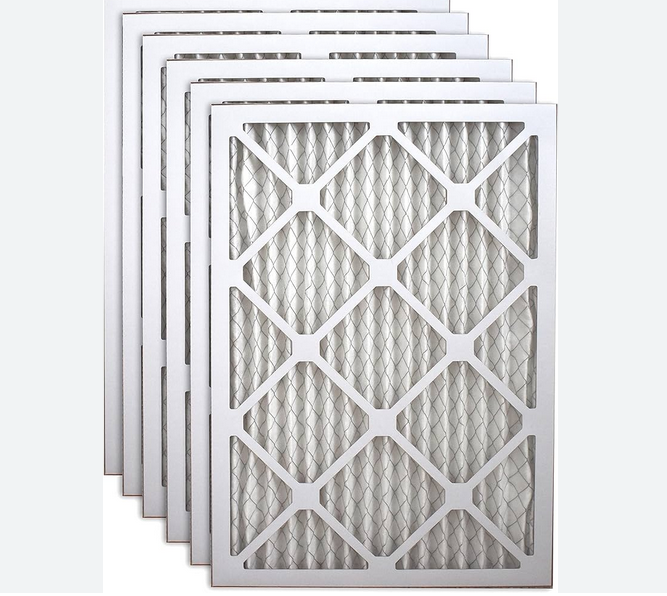
Filter brand
Most furnace filters are made of plastic and fiberglass, with a white or pale pleated surface when new.
High-quality furnace filter brands like Aprilaire, Camfil, Fantech, Honeywell, and Carrier tend to have similar lifespans but inferior-quality filters may need to be changed more frequently.
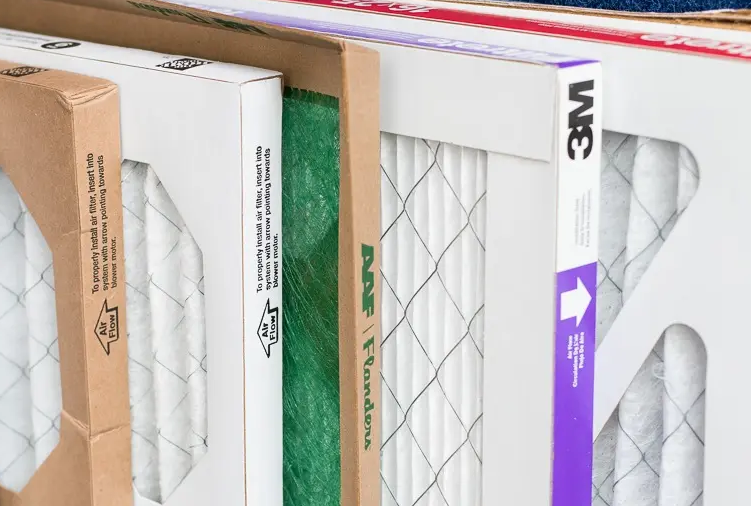
How do you know when it’s time to change a furnace filter?
Remembering to check or change your filters can be a challenge so it’s a good idea to set phone or calendar reminders to manage this relatively simple task.
Check your furnace regularly (preferably monthly) and keep a lookout for these tell-tale signs that your furnace filter needs attention:
- Unexplained increases in heating bills and energy costs
- Poor heating performance (rooms not heating up adequately)
- The furnace is blowing cold air
- Poor air quality inside the house
- Unexplained shutdowns of the heating system
- A damaged heat exchanger
- Increase in allergies or breathing issues
If you examine your furnace filter and it’s clogged with brown gunk instead of white or off-white, it needs replacing. A common test is to hold up the filter to the light—if the light doesn’t pass through it, replace the filter.

How do you change a furnace filter?
Most homeowners can handle basic furnace filter replacements but scheduling an annual prewinter furnace checkup and cleaning are essential to protect your furnace.
To change your furnace filter, you first need to identify where it’s located. It’s not always in the same place in a furnace and may vary depending on the design of your HVAC system.
Many attic furnaces, for instance, have the filter in a central ceiling register or “filter grill”, which opens from below.
Otherwise, your air filter slot is likely located near the air handler section of your furnace. It may be in the blower compartment, which is accessible through a metal door or hatch located on the bottom half of the furnace. Alternatively, it could be in a sliding compartment by the air handler or on a rack installed on the furnace’s side.
Here’s how to change a disposable air filter:
- Turn the thermostat and the furnace switch off.
- Remove the filter and hold it up to the light: if light cannot pass through it easily, it should be replaced.
- Install a new furnace filter purchased from any decent hardware store. They cost $10-20 and you can usually buy packs of multiple filters for discounts.
- Install the filter with the arrows pointing in the direction of the airflow.
- After furnace installation, make sure that you secure the access panel of the furnace.
- Turn the system back on.

Washable filters can be cleaned with a vacuum cleaner, rinsed with warm water and/or washed with gentle household soap using a soft brush.
FAQs
How often should you change a furnace filter in winter in Alberta?
During the winter in Alberta, the furnace works harder so you may need to replace the furnace filter almost every month. Checking it regularly is good practice anyway.
Humidity levels may also impact the replacement time of furnace filters. In summer, if the humidity is high, furnace filters can dampen, which can reduce the filter’s capacity to hold contaminants. Replacing the furnace filter may be necessary before using the heating system again.
What’s the best size furnace filter to buy?
HEPA air filters are used in home air purifiers, which some Alberta homeowners like to install (although these filters can also be installed as part of the HVAC system).
HEPA filters are highly effective at minimizing indoor pollutants and generally last much longer than standard furnace filters.
What’s the MERV rating of a furnace filter?
When you shop for furnace filters, you’ll see a MERV rating assigned to the filters. This stands for minimum efficiency rating value and is a measure of how efficiently the filter traps large particles between 0.3 and 10 microns.
A higher rating (13-16) indicates that the filter is better at trapping these particles than a lower rating.

Furnace tune-ups in Calgary
Changing your furnace filters regularly can enhance the performance, energy efficiency, and longevity of your HVAC system while also improving the air quality and comfort levels in your home.
We provide year-round furnace tune-ups for all types and brands of furnaces in Calgary. All of our furnace professionals are SAIT-certified and highly trained to get the job done efficiently.
Call us at 403-236-4366 or contact us online to book furnace maintenance.
